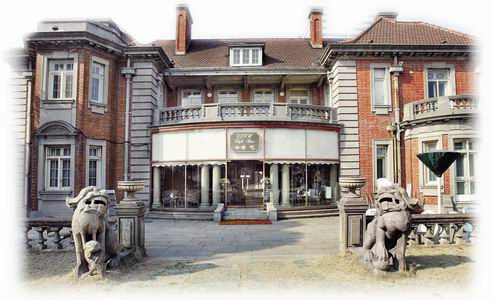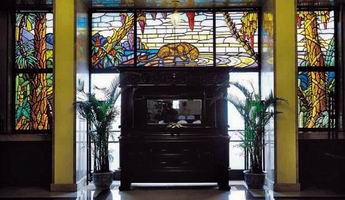Shanghai Daily News

Two stone sculptures of Chinese dogs guard one of the
buildings inside what is today the Ruijin Guesthouse, formerly one of the villas
on land owned by old Shanghai tycoon H.E. Morris.(Photo: Shanghai
Daily)

Stained glass windows, one of the few surviving
pieces from the Xujiahui St IgnatiusĄŻ workshop, are still rich in color after 56
years.(Photo: Shanghai Daily)
There were vaults for the silver, direct access to the greyhound racing and
the very latest architectural styles set in manicured gardens. Tina Kanagaratnam
explores the home of newspaper tycoon H.E. Morris, and finds a reflection of the
life of one of the wealthiest men in old Shanghai.
They don't make men like Henry (``Harry'') E. Morriss, Jr anymore. A Shanghai
tycoon born to a Shanghai tycoon, he had a taste for the finest things in life,
and the wherewithal to acquire them. And acquire them he did: horses,
greyhounds, a rare Stradivarius violin -- but the jewel in the crown was the
estate that he called home.
He was the son of H.E. Morriss, Sr, (``he made money and he married money,''
says Shanghai historian and author Tess Johnston), a British Catholic of Jewish
descent, who founded the The North-China Daily News, the most influential
English-language paper in China -- and perhaps all Asia -- in 1920s to 1940s.
The senior Morriss died in 1919, and by the 1920s, Harry, says Ralph Shaw (who
worked at the paper from 1937 to 1949) in the book ``Sin City,'' was ``in
supreme command'' of the newspaper from his second-floor office at No 17 The
Bund -- the ``old lady of the Bund.'' In keeping with his position, he purchased
almost one square block of land on Avenue Pere Robert, today's Ruijin No. 2
Road, in the former French Concession, for his estate.
Today, the manicured lawns and gracious buildings of the Morriss estate are
part of the Ruijin Guesthouse complex, but the grandeur is still palpable.
Ironically, the house that is most associated with the Morriss estate today --
Building 4, in which Face Restaurant is located -- is the one on the estate in
which the Morrisses probably never lived. The grand turn of the century mansion
predated Morriss' acquisition of the land -- perhaps the house was already on
the property or perhaps it was outside the perimeter but later became part of
the grounds.
Morriss' own house is Building No. 1, a gorgeous mansion in the French
Provincial style with a sloping, pitched roof. Popular throughout the world in
the first three decades of the last century, at the time that Morriss chose the
style, it would have been the very latest fashion. Positively cutting edge.
The house has a gravitas, a seriousness of purpose that comes from hiring
only the best architects and using the finest materials. Stepping into the
spacious entryway, dominated by six polished marble columns, one immediately
senses that this house has presence. The feeling is only magnified by the even
more spacious lobby, which leads to Mr Morriss' cozy, wood-paneled study, now a
bar. It's not difficult to imagine the lord of the manor reading in here, warmed
by the inglenook -- the fireplace, set in an alcove. It's not difficult, either,
to imagine the family servants in the next room, a dining room, polishing the
family silver in the walk-in vault that was used to store it.
It was perhaps in one of these grand rooms that Morriss played one of his
treasures: his ``Hellier'' violin. The Hellier is the most famous of Antonio
Stradivarius' inlaid violins, named for a Sir Samuel Hellier, who had purchased
it directly from Stradivarius in the 18th century. Morriss brought the
instrument to England with him in the late 1930s on a visit, but war was on the
horizon, and he did not bring it back with him when he returned home to Shanghai
in 1939 -- if he had, it almost certainly would have been confiscated, perhaps
even destroyed during the civil war and occupation that followed. Today, the
Hellier violin that once resounded in these rooms is on display at the
Smithsonian Museum in Washington, DC.
Perhaps one of the reasons that Morriss did not bring the Hellier back was
that he had received word that Italian consul-general had moved into the estate,
bringing home the instability of the times. A historical footnote: the consul's
name was Count Galeazzo Ciano, and he was married to Edda Mussolini, the
daughter of Benito Mussolini, and he reportedly hated Shanghai.
The grand stairs, with their solid wooden banisters, lead to a delightful
find: a wrought iron screen, on the second floor, with a happy mix of images
from East and West. Vibrant red flowers bloom from Italianate pots; a peacock
spreads its tail; and images of two traditional Chinese dogs, often found in
temple statuary, act as guards.
Morriss had a great liking for dogs -- especially the greyhounds he raced at
the Canidrome, fortuitously situated just behind his estate. At one time, there
was even an entrance in the wall that allowed Morriss to enter the Canidrome
grounds directly from his own grounds.
Greyhound racing was a favorite form of entertainment in old Shanghai,
especially as it involved betting, recalls Dora Carney in her memoir of prewar
Shanghai, ``Foreign Devils Have Light Eyes.'' The sleek, speedy greyhounds would
chase a mechanical rabbit around the Canidrome track, as boys raced up and down
the steps, collecting betting slips. The Canidrome still stands, a little worse
for wear, and is today the Jingwen Flower Market with its entrance on Shaanxi
Road.
The second floor, once the bedrooms and living area for the family, is now
the site of guest rooms and closed to the public.
Connected to the main house is the carriage house, with a half-timbered
facade, and a grand gateway through which (one imagines) motorcars passed on the
way to the house, or, perhaps, through which Mr Morriss rode on one of his
horses.
Morriss had two brothers, Hailey and Gordon. Hailey was something of a black
sheep (``he had blotted the family copybook,'' reported Shaw, ``by a long series
of sexual escapades that had taken him to court, to prison and to prominence in
the `News of the World'.'')
Gordon lived in Shanghai and ran the stock broking firm Lester, Johnson and
Morriss, which was in the building at No. 16 on the bund, right next door to the
newspaper's building. Gordon, too, was involved in the newspaper, and it was
perhaps he who lived in Building No. 3, the art deco beauty on the grounds.
The building, which was completed in 1949, is one of simple, clean lines --
once again, very cutting edge -- with streamlined columns, classic art deco
porthole windows and a geometric ironwork banister. But by far the most stunning
piece in this house is the trio of stained glass windows, depicting a lush
jungle scene; the colors still rich after 55 years.
It is the window in the middle that catches the attention: a beautiful golden
tiger drinking from a rippling jungle pool. It is a precious artifact: the
window is one of the few surviving pieces of stained glass from the famed
Xujiahui workshop, run by the Jesuit priests of St Ignatius to teach orphaned
boys of Shanghai a skill. (Xujiahui, in those days, says Johnston, ``was truly
Catholic country.'' There was a home for foundlings, a large orphanage, schools
and workshops for the education of the unfortunate, for girls in ``domestic arts
and needlework,'' for boys in ``working with wood or stained glass.'' Many of
their creations found buyers in Shanghai's other churches and even private
homes.'')
The date on the stained glass window reads 1949. Clearly, the Morrisses did
not anticipate how dramatically the Liberation would change their lives. After
all, through wars, occupations and changes of government, the Morrisses had
lived and prospered in Shanghai. They had made their considerable fortune in
this city, and in return, they had given her a prestigious newspaper and the
architectural legacy of a grand Bund building and a country estate. They had no
reason to assume that this particular change of government would change their
lives very much.
But it did. H.E. Morriss died before the Liberation, but his brother Gordon
remained in Shanghai, even after the new government turned his home into a
government guesthouse and banished him to the gatehouse of the manor where he
was once lord. The gatehouse is still there, on the right, as you enter from
Ruijin No. 2 Road.
After his death, his possessions were put on display. ``I thought that was
the end of the story,'' says Johnston, ``but then one day I got a letter from a
member of a much younger generation of the Morriss family. They are happily
living in England -- and still raising and racing horses.''



